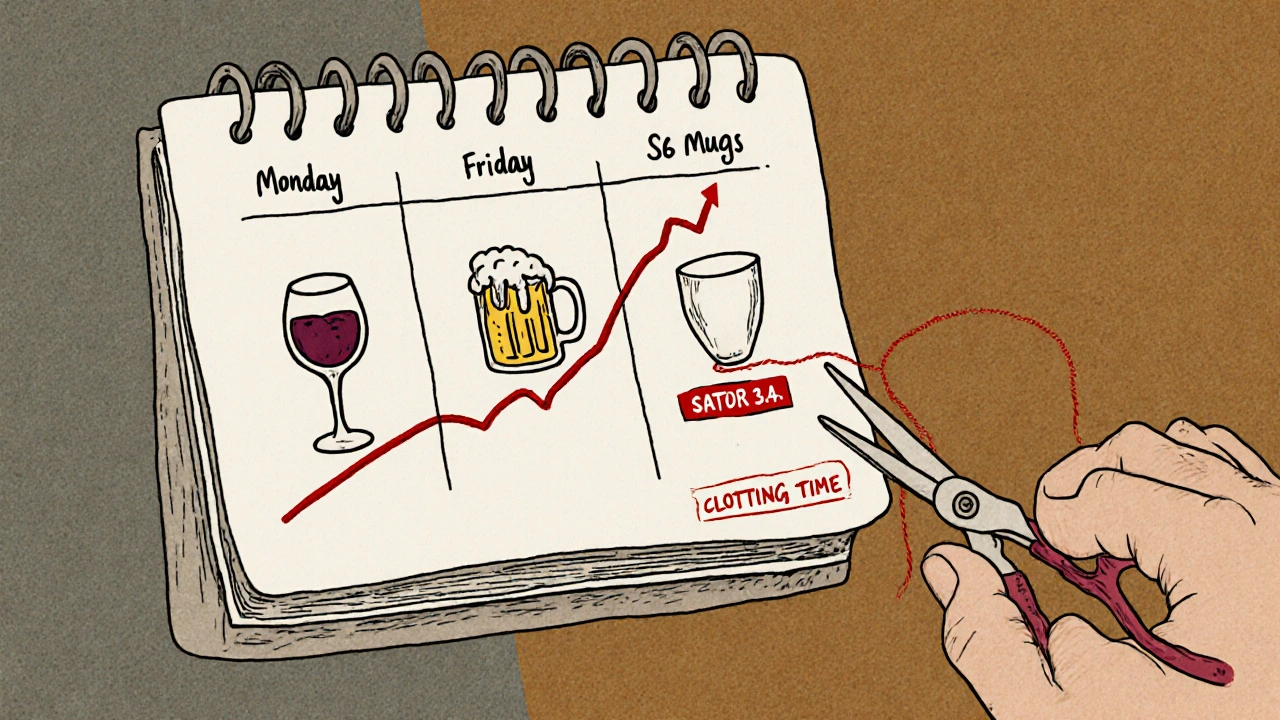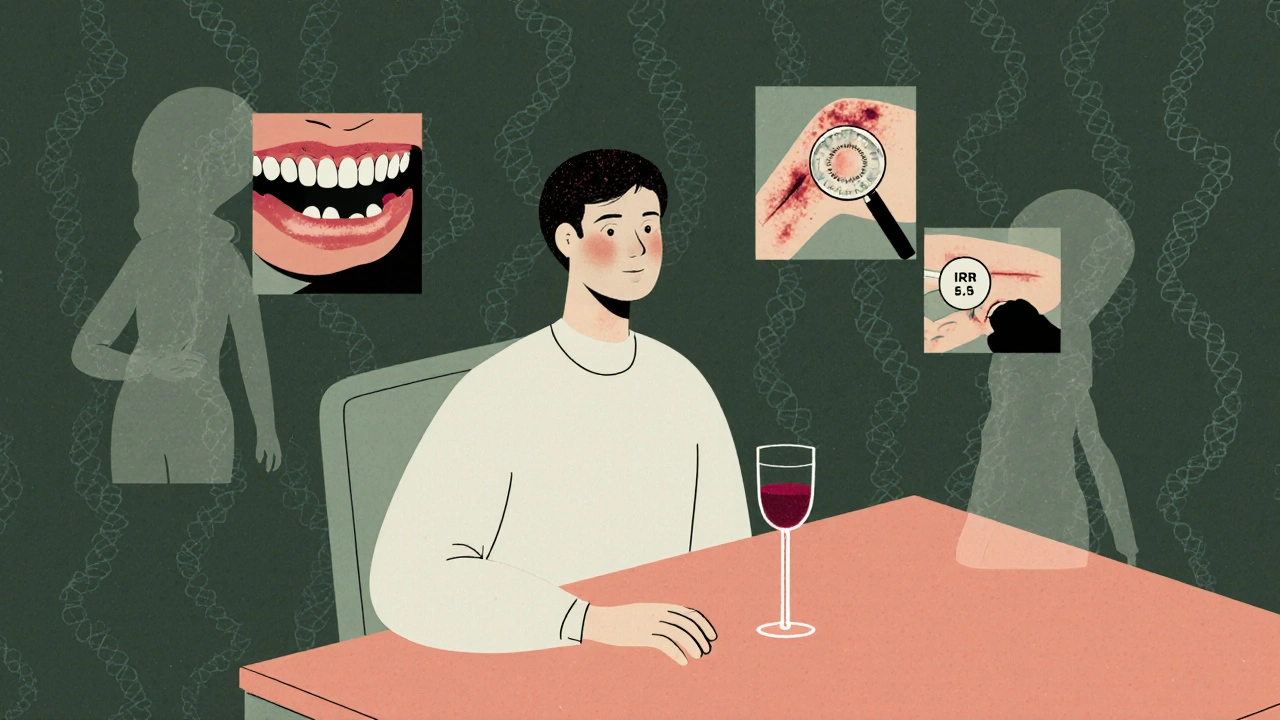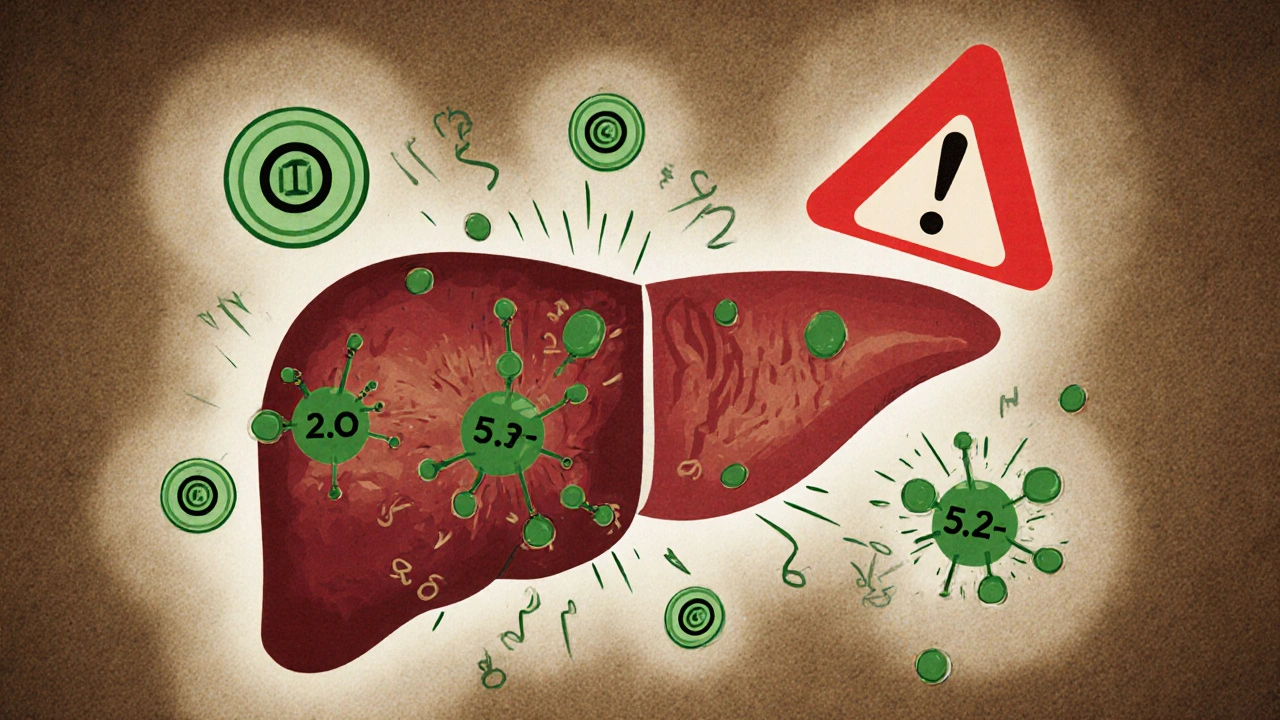Alcohol & INR Risk Calculator
INR Risk Assessment
See how alcohol consumption affects your bleeding risk while on blood thinners
Normal range: 0.8-1.2. Target range: 2.0-3.0 (varies by condition)
1 unit = 1 standard drink (12oz beer, 5oz wine, 1.5oz spirits)
When you're on a blood thinner like warfarin, even a simple glass of wine can become a medical decision. This isn't about fear-it's about understanding how alcohol quietly messes with your body’s ability to control bleeding. The key isn't whether you can drink at all, but how much, how often, and what it does to your INR.
What INR Really Means for You
INR stands for International Normalized Ratio. It’s a number doctors use to see how long it takes your blood to clot. If you’re not on blood thinners, your INR is around 1.0. But if you’re taking warfarin, your target is usually between 2.0 and 3.0. For some conditions-like a mechanical heart valve-it might go as high as 3.5.
Why does this matter? Because every 0.5-point increase above your target raises your bleeding risk by 30% to 50%. An INR of 4.0? That’s not just a little higher-it’s a red flag. At INR levels above 9.0, over one-third of hospitalized patients experience serious bleeding, and nearly one in five don’t survive. Even if you feel fine, your blood is dangerously slow to clot.
How Alcohol Throws Your INR Off Balance
Alcohol doesn’t just make you sleepy-it interferes with how your liver breaks down warfarin. When you drink, especially in large amounts, your liver gets busy processing alcohol instead of metabolizing the drug. That means warfarin sticks around longer, making your blood thinner than intended.
But here’s the twist: sometimes alcohol does the opposite. Heavy drinking over days or weeks can damage your liver, reducing its ability to make clotting factors. That also raises your INR. So alcohol can either spike your INR or make it unstable, and you won’t always know which until you get your blood tested.
Research from the American Journal of Clinical Pathology shows that among patients with INR over 9, alcohol use was one of the top three reasons for dangerous bleeding-alongside older age and kidney problems. It’s not rare. About 30% to 40% of people on warfarin drink alcohol regularly, and many don’t realize how much it’s affecting them.
Real Stories, Real Risks
A 62-year-old man in the UK drank six pints of beer over two days. His INR jumped from 2.8 to 5.2. He ended up with internal bleeding in his stomach. He didn’t fall or get hurt-he just drank. That’s how quietly this works.
On Reddit, users share stories like: "I had four glasses of wine on Saturday. My INR went from 2.4 to 3.8 by Monday. My doctor said it’s common." Another wrote: "I thought one drink a night was fine. Then I started bleeding from my gums. My INR was 5.5. I stopped drinking cold turkey. My INR dropped back to 2.6 in two weeks."
These aren’t outliers. They’re textbook cases. Even moderate drinking-two or three drinks in a weekend-can trigger changes that require a warfarin dose adjustment. And if you’re someone who drinks heavily once a week but stays sober the rest of the time, that binge pattern is worse than daily light drinking. Your INR swings like a pendulum, and each swing increases your risk.

Genetics Play a Bigger Role Than You Think
Not everyone reacts the same way to alcohol and warfarin. Your genes matter. Some people have a variation in the CYP2C9 or VKORC1 genes that makes them extra sensitive to warfarin. When they drink, their INR spikes faster and higher than others.
A 2015 NIH study found that patients with these genetic variants had a much higher risk of major bleeding when they drank alcohol-even at moderate levels. If you’ve been on warfarin for over a year and keep having unexplained INR changes, ask your doctor about genetic testing. It might explain why your numbers don’t match what others experience.
Warfarin vs. Newer Blood Thinners
Not all blood thinners are the same. Warfarin is old, cheap, and requires constant monitoring because it interacts with food, other drugs, and alcohol. Newer options like apixaban, rivaroxaban, and dabigatran (called DOACs) don’t need regular INR tests and have fewer interactions.
But here’s the catch: DOACs don’t have easy reversal agents for emergencies. If you bleed badly on warfarin, doctors can give you vitamin K or plasma to quickly fix it. For DOACs, reversal is harder and slower. So even though DOACs are more predictable with alcohol, they’re not risk-free.
That’s why many people still take warfarin. It’s used in over 2.5 million Americans each year. If you’re on it, you’re not alone-but you do need to be extra careful.
What’s Safe? The Real Guidelines
The NHS, British Heart Foundation, and Medical News Today all agree: you can drink alcohol while on warfarin-but only if you stick to strict limits.
- Don’t exceed 14 units of alcohol per week (that’s about six 175ml glasses of wine or six pints of beer).
- Spread it out over three or more days. No binge drinking.
- Avoid drinking more than one or two drinks in a single day.
- Never mix alcohol with other medications that thin your blood, like aspirin or ibuprofen.
One drink? Usually fine. Three drinks in one night? Risky. A six-pack on Friday and another on Saturday? Dangerous. Your INR doesn’t care about your intentions-it reacts to the amount and timing.

Signs You’re Bleeding-Don’t Wait
If your INR is high, you might not feel anything until it’s too late. Watch for these signs:
- Red or brown urine
- Black, tarry, or bright red stools
- Nosebleeds that won’t stop
- Bleeding gums when brushing your teeth
- Unusual bruising, especially without injury
- Heavier menstrual bleeding than normal
- Brown or bright red vomit
If you see any of these, call your doctor or go to the ER. Don’t wait for your next INR test. Bleeding can turn life-threatening fast.
What to Do If You Drank Too Much
If you had a weekend of heavy drinking and your next INR test is days away, call your clinic. Some telehealth services now offer same-day INR checks for patients who’ve had alcohol binges. A 2023 study showed patients who got this kind of support had 25% fewer dangerous INR spikes.
Don’t skip your test. Don’t guess. Even if you feel fine, your blood might not be.
Bottom Line: Control the Variables
Warfarin works best when your life stays predictable. Eat similar amounts of vitamin K-rich foods. Take your pill at the same time every day. And limit alcohol to small, consistent amounts.
Alcohol isn’t banned-it’s a variable you manage. If you drink, keep it light and steady. If you don’t drink, don’t start. Your INR is a window into your body’s clotting system. When alcohol clouds that window, you’re flying blind. And in this case, blind means bleeding.
Can I have one glass of wine while on warfarin?
Yes, one standard glass of wine (5 oz) is generally safe if you drink it occasionally and stick to the weekly limit of 14 units. The key is consistency-don’t have a glass every night one week and six on the weekend the next. Sudden changes in alcohol intake are what cause INR spikes.
Does beer affect INR differently than wine or spirits?
No, the type of alcohol doesn’t matter-it’s the amount of ethanol that counts. One pint of beer, one glass of wine, and one shot of spirits all contain about the same amount of alcohol. What matters is how much you drink in total and how often.
What if I forget I’m on warfarin and drink heavily?
If you’ve had a binge (more than 4 drinks in one day), contact your healthcare provider right away. Don’t wait for your next test. You may need an emergency INR check. Avoid taking your next warfarin dose until you’ve spoken to your doctor-especially if you’re also showing signs of bleeding.
Can I drink alcohol if I’m on a different blood thinner like Xarelto or Eliquis?
Yes, but with caution. DOACs like Xarelto and Eliquis have fewer alcohol interactions than warfarin, but heavy drinking still increases bleeding risk. Alcohol can irritate your stomach lining and make you more prone to internal bleeding. Stick to moderate drinking, and never binge.
How long does alcohol affect INR?
The effects can last up to 72 hours after your last drink, especially if you drank heavily. Your liver needs time to clear alcohol and return to normal warfarin metabolism. That’s why doctors recommend avoiding alcohol for at least 24-48 hours before your INR test to get an accurate reading.
Should I stop drinking alcohol completely while on warfarin?
Not necessarily. Many people manage warfarin successfully while drinking moderately. The goal isn’t total abstinence-it’s control. If you can limit yourself to 1-2 drinks, spread out over the week, and avoid bingeing, you can reduce your risk significantly. But if you struggle to stick to limits, quitting is the safest choice.

David Cunningham
November 23, 2025 AT 21:59
Been on rivaroxaban for 3 years. One beer after work, sometimes two on weekends. Never had an issue. But I know folks on warfarin are a whole different ballgame. This post was super helpful.
Mark Williams
November 23, 2025 AT 22:15
INR variability is a pharmacokinetic nightmare when combined with CYP2C9 polymorphisms. Alcohol induces transient hepatic enzyme inhibition, leading to prolonged warfarin half-life. The 30-50% bleeding risk increase per 0.5 INR unit above target is well-documented in the 2018 Anticoagulation Forum guidelines. Genetic testing isn't optional-it's stratification.
Daniel Jean-Baptiste
November 25, 2025 AT 07:29
so i read this and thought hey maybe i should cut back on my weekend beers. i dont even know what inr stands for but i know my doctor gets nervous when i drink. thanks for the clarity. also i typoed half this comment lol
Ravi Kumar Gupta
November 26, 2025 AT 15:01
In India, we drink whiskey with water and ice, sometimes three pegs on Friday. My uncle on warfarin? He drinks like this and his INR is always 2.9. He says, 'Doctor, if I stop drinking, I will die of boredom.' He’s right. Life is not about zero risk. It’s about smart risk. Respect the medicine, but don’t become its slave.
Rahul Kanakarajan
November 28, 2025 AT 13:06
People who drink 'one glass' are delusional. One glass turns into two, then three, then 'it's just Friday.' You think you're in control until your gums bleed and your INR hits 6.5. This isn't moderation-it's self-deception. Stop lying to yourself.
ann smith
November 28, 2025 AT 19:52
Thank you for this. I’ve been on warfarin for 5 years and never realized how much alcohol could swing my numbers. I’ve cut back to one glass of wine on Sundays only. My INR has been stable for 6 months now. You’re not alone ❤️
New Yorkers
November 29, 2025 AT 00:13
Alcohol is just another form of self-harm disguised as relaxation. You think you're celebrating life, but you're just flirting with hemorrhage. The liver doesn't care about your feelings. Your INR doesn't care about your intentions. You're playing Russian roulette with your own blood.
Patrick Marsh
November 30, 2025 AT 19:18
One drink. One day. No more.
Julie Pulvino
December 2, 2025 AT 06:15
I used to drink wine every night. Then I started bruising for no reason. I called my doctor, got tested, INR was 4.8. I stopped drinking for a month. Now I have one glass every other weekend and feel way better. It’s not about giving up-it’s about choosing your health.
Danny Nicholls
December 3, 2025 AT 12:57
Just had my first INR test after 3 beers last weekend 😬 turned out okay (2.9) but I’m definitely cutting back. Thanks for the reminder 🙏 also if you’re on DOACs and drink, just don’t be a dumbass. We all know what that looks like 🤦♂️
luke young
December 5, 2025 AT 09:37
Love how this post doesn’t scare people-it just gives facts. My dad’s on warfarin and he still has a glass of wine with dinner. He tracks his intake, never binges, and gets tested every 4 weeks. Simple. Consistent. Safe. That’s the real win.